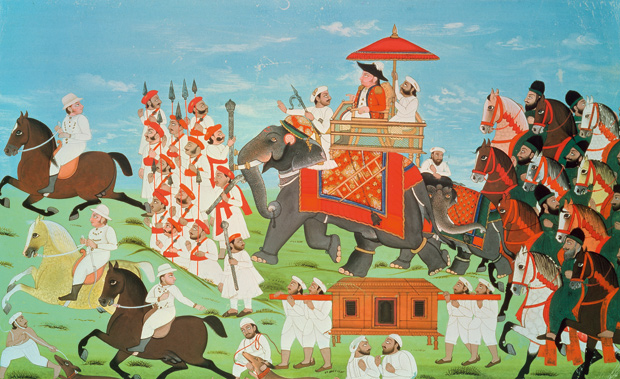From the Greek seafarer Scylax in 500 BC to the Beatles in 1968, there is a long history of foreign visitors being drawn to India. Many have come in search of the ‘exotic’ or the ‘other’, an idea of India that persists despite the best efforts of Edward Said’s post-colonial disciples. Not unnaturally, the Indian ministry of tourism colludes in this, their website displaying photographs of flower-bedecked idols, brightly painted elephants and smiling dancing girls, and encouraging the browser to ‘Match India’s rhythms to your heart, its colours to your mind, and find a travel experience that is yours alone…’
Down the centuries foreigners have also come to India for rather more concrete reasons: the promise of trading opportunities and great wealth; invasion, conquest and the creation of empires; imperial service and missionary work; spiritual enlightenment. In his wide-ranging and hugely entertaining new book, Sam Miller explores the varied motives that brought people to India, their experiences when they got there, and the portraits they provided of the country and its people in the form of letters, diaries, memoirs, travel books, novels, poems and would-be anthropological, archaeological, cultural and other studies.
As in Miller’s earlier book Delhi: Adventures in a Megacity (2009), A Strange Kind of Paradise consists of main chapters with brief ‘intermissions’. The chapters follow a broadly chronological path and bear titles parodying those of a 19th-century adventurer (‘Chapter Eight: In which the Author is slightly rude about the Taj Mahal, considers the curative powers of cows’ urine, and fails to take a nuanced view of sati’), while the intermissions tend to be autobiographical. Miller married into a Bombay Parsi family, travelled widely in India as a correspondent for the World Service during the early 1990s, and has lived in Delhi since 2002; and while he insists that it is impossible to ‘know’ any country, let alone one as populous and diverse as India, he writes from a wealth of personal subcontinental experience.
The first reliably detailed account of India was provided by an ambassador called Megasthenes, sent in the early years of the third century BC from the eastern empire of Alexander the Great to the court of King Chandragupta at Pataliputra, a vast and sophisticated city which stood on the site of modern Patna. Like Scylax before him, and many of those who came after (including Marco Polo and Sir John Mandeville), Megasthenes told unlikely tales of the fabulous monsters to be found in India, but elsewhere and more plausibly he described culture, architecture, engineering, army formations and government administration, as well as the inevitable tigers and elephants, and his Indika ‘cuts a small window through the opaque haze of ancient history’.
Other visitors were less favourably impressed, even or perhaps especially when they arrived with various forms of conquest in mind. Miller describes St Thomas, on a mission to spread Christianity and sexual continence through the subcontinent, as ‘a pretty strong candidate for the most reluctant visitor to India of all time’, though similar claims could be made for Vasco da Gama, the emperor Barbur or Sir Thomas Roe.
Da Gama, ‘like a significant percentage of visitors to India ever since, became angry when things went wrong’, his bad temper resulting in the slaughter or forcible conversion to Christianity of a shipload of Muslim pilgrims. The memoirs of Barbur, the first Mughal emperor, though lively, were filled with complaints about the land he had invaded and subjugated:
There is no beauty in its people, no graceful social intercourse, no poetic talent or understanding, no etiquette, nobility or manliness. There are no good horses, meat, grapes, melons or other fruit.
The spectacularly unimaginative Roe, sent as an envoy by James I to the court of Jehangir, refused to be impressed by the fabled splendours of the Mughal empire, declaring India on his return ‘the dullest, basest place I ever saw’.
It wasn’t until the 18th century that there was a genuine attempt to engage with India, its customs, religions, history and culture. William Jones’s Asiatick Society of Bengal was founded in Calcutta in 1784, but Miller refreshingly discusses the scholars and writers from other European countries —including Schlegel, Herder, Novalis, Heine, Lamartine, and the beautifully named Abraham-Hyacinthe Anquetil-Duperron — who became caught up in ‘Indomania’. As Miller points out, many of these scholars ‘were no more interested in modern India than classicists were in modern Greece’, and the disjunction between an aesthetic appreciation of Indian history and culture and a proper interest in the day-to-day realities of those who live there is one that has persisted.
It is from the late 18th century onwards that foreign accounts of India proliferate, and Miller gives an excellent overview of them, with an eye to picking out less familiar texts. For the ‘Mutiny’ of 1857, for example, he quotes the disgracefully vengeful pronouncements of Dickens and De Quincey, but also turns to forgotten novels that side with the Indians against the British: the 1,400-page Nena Sahib or the Uprising in India (1858), sneakily written under an English pseudonym by an Anglophobe anti-Semite called Hermann Goedsche (one of whose novels provided the inspiration for The Protocols of the Elders of Zion), and Alfred Assollant’s almost equally disobliging Adventures merveilleuses mais authentique du Capitaine Corcoran (1867), which features a pet Javanese tiger called Louison and sounds rather more fun.
Miller suggests that ‘visitors to India have usually been able to find, somewhere, somehow, what it is in India that they were expecting to find’ —and this is not always to India’s advantage. It is easy now to dismiss Mother India (1935), in which an American journalist called Kathleen Mayo claimed that Hindus were morally and physically enfeebled by widespread sexual activity during childhood and were therefore unfit for self-government, but this best-selling travesty was translated into 13 languages, sent to every British MP, and was still (along with Kipling) one of the main sources of information about India in America in the 1950s. A similar determination to see only the worst of the country infects V.S. Naipaul’s An Area of Darkness, which Miller instructively compares with Allen Ginsberg’s contemporaneous and enthralled Indian journals.
There is a huge amount of material here and if occasionally Miller gives the impression of someone trying to cram more into a suitcase than it can possible hold, none of this, or the occasional slip or repetition, detracts from the book’s immense readability. Indeed, given the subject, it seems appropriate that facts and figures spill engagingly into numerous, extensive and digressive footnotes about anything from Francis Xavier having a toe bitten off (post mortem) by a Portuguese woman in Goa to Norman Wisdom’s years in Lucknow as a bandsman in the 10th Hussars, ‘where he won the British army flyweight championship, and learned to fall off horses in order to amuse the memsahibs’.






Comments